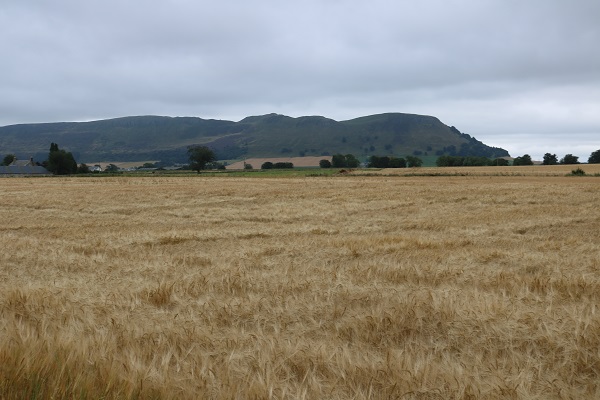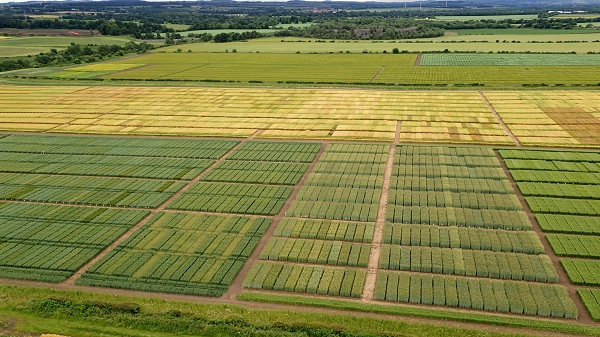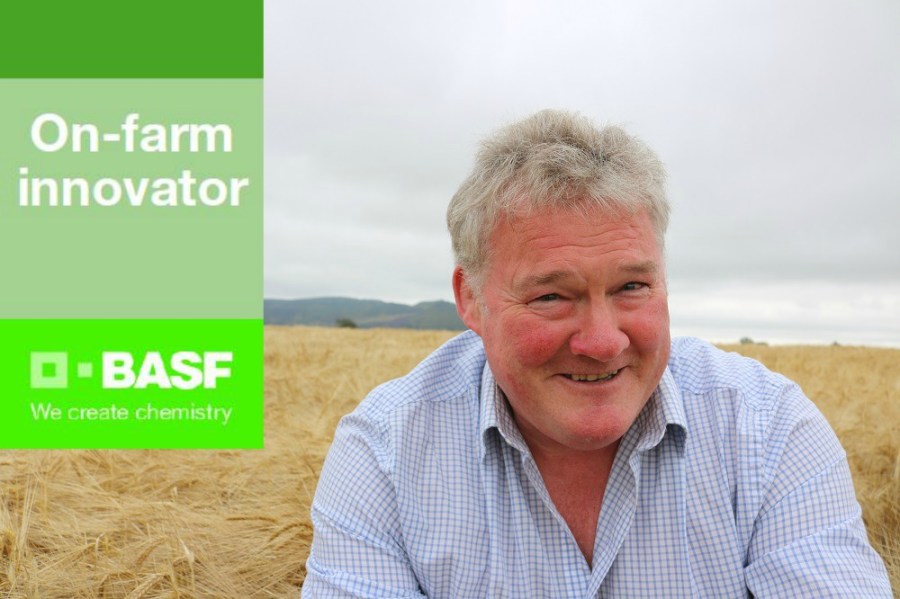Scottish Agronomy boasts the largest trials network north of the border, but its managing director feels it’s the sharing of research and ideas within its farmer membership that gives it real strength. CPM finds out.
The group system is what really makes our agronomy service efficient.
By Tom Allen-Stevens
It’s mid-afternoon in the last week of August, and while the bulk of England basks in the hottest temperatures of the year, the Scottish Agronomy trial plots near Loch Leven sit beneath a grey pall, with the peaks of the nearby hills shrouded in mist.
“Welcome to the glorious Scottish summer,” comments Andrew Gilchrist, the company’s managing director, as he passes his hand over a somewhat lacklustre plot of spring barley that should be passing through the plot combine that very afternoon.

Scottish Agronomy has built its reputation on making the most of the Scottish climate, and turning it into profitable crops for its farmer members.
The harvest may be on hold, but these trial plots may represent what Scottish Agronomy has built its reputation on – making the most of the Scottish climate, and turning it into profitable crops for its 180 farmer members. What’s more, it has a fairly unique way of delivering this across the main arable area from the Borders to north of Inverness, as Andrew Gilchrist explains.
“The core of the membership is sub-divided into groups of 8-12 local farmers. We meet each month, rotating the location around the membership, to discuss arable issues, then usually combine this with a farm walk in the afternoon. The group structure facilitates a collaboration between farms, not only of agronomic practice and ideas but also of informal machinery and resource-sharing. It’s been at the core of the system from the start.”

Now the largest trials organisation in Scotland, Scottish Agronomy has over 25,000 plots across 10 sites.
The company started in 1985. At the time, Andrew Gilchrist had recently left college in Edinburgh and had started working with the BASF trials team in Scotland. “I did the second part of my industry placement with the team, working with Huw Philips, and this got me really enthusiastic about agronomy. It was Huw who came up with the concept of a co-operative trials-based agronomy company, generating independent information for its members. He left to set up Scottish Agronomy and I accepted the offer to join him. It’s grown ever since.”
It’s the trials side of the business for which the company may be best known. “We started by tackling areas that weren’t being addressed anywhere else for the Scottish grower. Back then, there were new triazole fungicides being introduced and we wanted to evaluate how they should be best matched to the crops and climate of Scotland. We established a niche in unbiased trials work.”
Trials network
Now the largest trials organisation in Scotland, Scottish Agronomy has over 25,000 plots across 10 sites. These form the basis of research into the agronomy of new varieties and crop inputs, not just for its members, but also for a number of commercial interests.
“It’s a side of the business that’s really grown arms and legs over the past 10 years,” he comments. “The statistical analysis of our trials programme has always been very robust, and we try to achieve a good coefficient of variation. We’re working with most of the main players in the industry and the income keeps the cost down for members, helps us invest in the best equipment and means we can resource the programme well.”
The members also benefit from an insight into a vast array of agronomic inputs that come under scrutiny. One of the areas in which it leads is in evaluating varieties, and barley in particular.
“The variety trials form a massive part of what we do. We look at them from the mini-plot stage right through to AHDB Cereals and Oilseeds Recommended List trials, so it’s quite likely we’ve 7-8 years of experience with a variety before it’s even launched on the market,” says Andrew Gilchrist.
“There are few other trials providers who can replicate the disease spectrum experienced by the Scottish grower to the extent that we can. If you look at the two-row feed winter barleys, for example, and how they’ve progressed in recent years, we’ve looked at these intensively, tailoring fungicide and seed-rate interaction to produce the most efficient agronomic blueprint. That’s our stock in trade.”
He’s keen the trials programme helps develop other areas for Scottish growers. “We’ve been looking into hybrid rye for around three years, working with KWS and Saaten Union. Its use for anaerobic digesters is well documented, but I think its potential as a feed grain in Scotland is the more interesting area.”
Modern hybrids such as KWS Magnifico and SU Performer aren’t quite as tall as the 2m monster conventional varieties. “They look bulky, but they’re actually quite stiff and stand well, provided they receive a reasonable PGR programme, and they go through the combine better than you might think.”
But the real surprise is the yield. “In our trials, hybrid rye can outperform wheat for half the production cost – it has a considerably lower N requirement and needs less fungicide. It has potential for wholecrop forage as well as a feed grain alternative to wheat or barley – we’re pitching for Scottish Government funding to take it further,” he says.
Alternative methods
On the cereal fungicide side of the trials, he feels the future lies in varietal resistance and alternative methods of disease control. “We carry out some of the AHDB fungicide performance trials and I’ve seen how septoria control is slipping – in some situations we’re struggling to control it with a double dose.
“We’ve had the best days out of the SDHIs and the chemistry is really under threat. We now need more emphasis on varietal resistance. Looking forward, biocontrol agents in combination with conventional chemistry have real potential and it’s something we’re looking into. We know they work, but the key to success is finding the right delivery mechanism, and that’s going to require a lot of trials work, both in plots and on farm,” he notes.
On-farm field-scale trials work is an area Scottish Agronomy develops with its members, and it’s an essential element of the collaborative nature of its agronomy service. “We have one grower doing a variable seed-rate trial, to assess the value of this technology. He’s planted at four different rates in strips across a field where the soil type and aspect varies. We’re looking closely at the spatial variability, taking plant and ear counts as well as taking it to yield.”
On the precision farming side, there’s now a link up with specialists Soil Essentials, with a pilot group of farmers within the Scottish Agronomy membership, looking at yield data from different years. This is overlaid with other spatially variable data and amalgamated to build up what Andrew Gilchrist believes is a truer picture of field variability.
“Our members have spent a lot of time, money and resources on precision farming, and they’re keen to make the most of it – it’s an area where the collaboration really pays off.”
And it’s this aspect of sharing ideas within the group that is the real strength, he says. “One example is in min-till – Scottish growers are some way behind those in England in how the system has developed, but a number have adopted systems, and some have worked while others haven’t. But they’ve been willing to show their failures as well as their successes within their local groups, and that’s been a benefit to all,” he notes.
“It also gives us agronomists excellent feedback on costs of production and keeps us in touch with what matters to our members and where we should take our research. We have our one-to-one bespoke agronomy service, with regular crop-walking. But the group system is what really makes our agronomy service efficient, as well as enjoyable and rewarding.”
Working together brings real progress in on-farm trials
It takes a level of trust and dedication to achieve a collaboration where everyone benefits, believes BASF agronomy manager for Scotland Dudley Kitching, which is what Andrew Gilchrist has developed with Scottish Agronomy.
“That’s not just the way he works with the farmer members – it’s a reflection of the relationship Scottish Agronomy has with manufacturers and agricultural trade partners, too,” he says.
“What Scottish Agronomy has done is develop a programme of trials, not just in the plots but on farm, and not just about chemistry, but much broader into total agronomy. This is then focused on the local area and the climate and conditions the company’s farmer members face.”
He reckons the collaborative approach to bringing results to members also works well. “Some growers talk about working with others, but often don’t. Here there is a structure that maintains a true sharing of ideas – a safe and trusted environment to discuss failures as well as successes.”
The trials include some true innovations, he points out. “Rye is a crop that works well in other northern European countries. The Scottish Agronomy trials have shown hybrid rye can work well for Scotland, too, and this could be a real opportunity if a market can be developed.”
And there’s a dedication that drives this forward. “Those who know Andrew will know his passion for the industry and determination to do what’s best for Scottish Agriculture. On the trials side, he knows how to balance sharing results with farmers without betraying confidential agreements and commercial sensitivities.”
Getting that balance right is the keystone of making the most from applied agronomic research, he believes. “Trials, both in plots and on farm, work well when they look outside the norm and think forward to the next challenge. You need to focus on the right issues and balance ‘nice to have’ with ‘need to have’. You also should be prepared to fail – it can often teach you more than success.”
BASF has worked with Scottish Agronomy to help develop solutions for Scottish growers and agronomic practices to address particular issues. One example in particular was developing PGR recommendations for oats following concerns over maximum residue limits of chlormequat.
“We value the quality of the work that Scottish Agronomy does and how this is applied on farm. But it goes much wider – the chemistry we bring to market works best when we work with partners who can help us develop it into on-farm solutions. That goes right from innovations through to tried and trusted products, and right from high-level research through to split-field comparisons carried out by individual growers,” he says.

How to be an on-farm innovator – Andrew Gilchrist’s top tips
- Have the ability to measure. To carry out a reliable on-farm trial requires some degree of accuracy in mea
suring the output. A good combine yield monitor may be enough, although a weighbridge is better. You also need some discipline on farm to combine, weigh and record the assessed plots separately. - Choose the right issue to focus on. The best on-farm trials are those that build on a thorough understanding and knowledge of a particular topic. So stay abreast of the arable conversation through the farming press and farmer meetings, which will help you
decide what would be best to trial and bring you most value. - Commit and follow through. Be thorough in your set-up and approach, and once you’ve determined on a particular trial and procedure, stick to your methodology and continue through to yield to ensure you have valid results.
- Cultivate your contacts. You may need specialist equipment, help or support with your trial. It’s a time to draw on favours and ask around – you may be surprised what people would willingly offer to be involved.
- Keep a scientific approach. You don’t have to evaluate CVs or undertake statistical analysis, but you should approach a trial objectively, make sure the variables are measurable and take the results at face value, even if they go against your expectations.
- Don’t be afraid of failure. An inconclusive result is still positive – it at least shows any benefit of an input/system is inconsistent and will point a way to further investigation.




